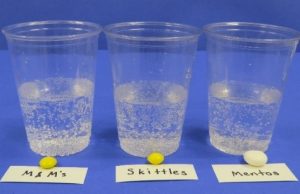Have you ever noticed that when you put a straw in soda pop, the straw gets covered with bubbles? The bubbles are made from a gas called carbon dioxide. The soda pop company puts the carbon dioxide in the soda to give it that special fizz. You can see some of this carbon dioxide fizz, bubble, and pop in this activity with soda pop!
Here's what to do:
- Fill a cup about 3/4 full of soda pop. Place a straw in the soda and look closely at the straw from the side of the cup. What do you notice?
- Try putting a pipe cleaner or a popsicle stick into the soda and looking at them from the side. Do bubbles form on these too?


- Try dropping a pinch of sugar or salt into the soda. What do you notice?

What to expect
Bubbles form on the straw, salt, sugar, pipe cleaner and popsicle stick.
What's happening in there?
Bubbles form on the different objects because of the carbon dioxide gas in the soda pop. Even though the straw, popsicle stick, and other objects might seem smooth, they actually have many tiny little bumps, indentations, and scratches where the carbon dioxide molecules attach. Once the carbon dioxide molecules have a surface to attach to, the molecules build up and form bubbles.
What else could you try?
As you’ve seen, carbon dioxide from soda pop can form bubbles on lots of different objects. Some of the greatest soda bubble formers are round candies like M&Ms, Skittles, and especially Mentos. Let’s compare them!
What you'll need:
- Any clear colorless soda (Club soda, Sprite, or 7-Up)
- 3 clear plastic cups
- M&M
- Skittle
- Mento
Be safe
Be sure to review the safety instructions on page 1 before proceeding.
Here's what to do:
- Pour about 1/2 cup of the same soda into each of three clear plastic cups.

What's happening in there?
- At the same time, place an M&M, Skittle, and Mento in each cup and watch from the side.
What do you notice? Was there a difference in how fast or how many bubbles formed on each candy?

What to expect
Tiny bubbles quickly form on all the candies and rise to the surface in a stream. The candy does not rise to the surface but some of the coloring from the M&M and Skittle comes off and some of the coating from the Mento seems to come off too.
What's happening in there?
Even though the candies seem smooth, they have extremely tiny bumps and uneven areas on the surface where carbon dioxide molecules attach and form bubbles. The most bubbles form on the Mento maybe because it’s the biggest or maybe because its surface is rougher and better for carbon dioxide molecules to attach and form bubbles.
